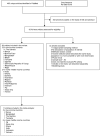Carriage of Streptococcus pneumoniae and other respiratory bacterial pathogens in low and lower-middle income countries: a systematic review and meta-analysis
- PMID: 25084351
- PMCID: PMC4118866
- DOI: 10.1371/journal.pone.0103293
Carriage of Streptococcus pneumoniae and other respiratory bacterial pathogens in low and lower-middle income countries: a systematic review and meta-analysis
Abstract
Background: Infection with Streptococcus pneumoniae is a major cause of childhood morbidity and mortality worldwide, especially in low income countries where pneumococcal conjugate vaccines (PCVs) are still underused. In countries where PCVs have been introduced, much of their efficacy has resulted from their impact on nasopharyngeal carriage in vaccinated children. Understanding the epidemiology of carriage for S. pneumoniae and other common respiratory bacteria in developing countries is crucial for implementing appropriate vaccination strategies and evaluating their impact.
Methods and findings: We have systematically reviewed published studies reporting nasopharyngeal or oropharyngeal carriage of S. pneumoniae, Haemophilus influenzae, Moraxella catarrhalis, Staphylococcus aureus, and Neisseria meningitidis in children and adults in low and lower-middle income countries. Studies reporting pneumococcal carriage for healthy children <5 years of age were selected for a meta-analysis. The prevalences of carriage for S. pneumoniae, H. influenzae, and M. catarrhalis were generally higher in low income than in lower-middle income countries and were higher in young children than in adults. The prevalence of S. aureus was high in neonates. Meta-analysis of data from young children before the introduction of PCVs showed a pooled prevalence estimate of 64.8% (95% confidence interval, 49.8%-76.1%) in low income countries and 47.8% (95% confidence interval, 44.7%-50.8%) in lower-middle income countries. The most frequent serotypes were 6A, 6B, 19A, 19F, and 23F.
Conclusions: In low and lower-middle income countries, pneumococcal carriage is frequent, especially in children, and the spectrum of serotypes is wide. However, because data are limited, additional studies are needed to adequately assess the impact of PCV introduction on carriage of respiratory bacteria in these countries.
Conflict of interest statement
Figures


References
-
- World Health Organization (2012) Estimated Hib and pneumococcal deaths for children under 5 years of age, 2008.
-
- Simell B, Auranen K, Kayhty H, Goldblatt D, Dagan R, et al. (2012) The fundamental link between pneumococcal carriage and disease. Expert Rev Vaccines 11: 841–855. - PubMed
-
- Whitney CG, Pilishvili T, Farley MM, Schaffner W, Craig AS, et al. (2006) Effectiveness of seven-valent pneumococcal conjugate vaccine against invasive pneumococcal disease: a matched case-control study. Lancet 368: 1495–1502. - PubMed
-
- Miller E, Andrews NJ, Waight PA, Slack MP, George RC (2011) Herd immunity and serotype replacement 4 years after seven-valent pneumococcal conjugate vaccination in England and Wales: an observational cohort study. Lancet Infect Dis 11: 760–768. - PubMed
Publication types
MeSH terms
Substances
Grants and funding
LinkOut - more resources
Full Text Sources
Other Literature Sources
Medical

